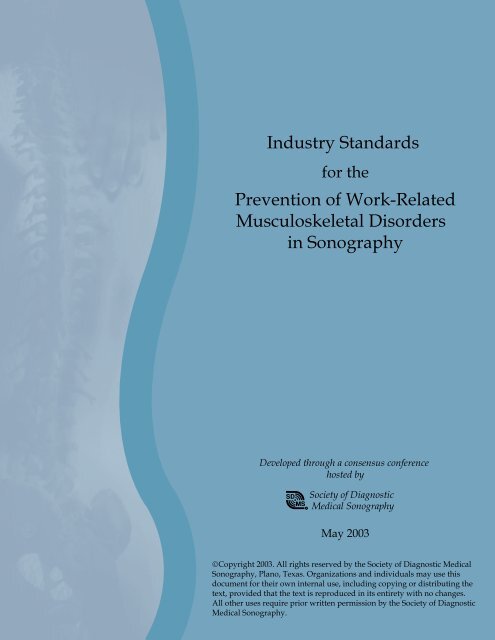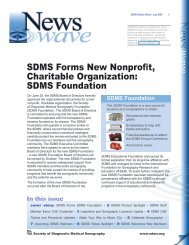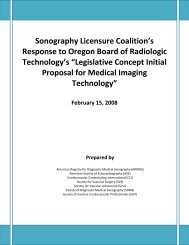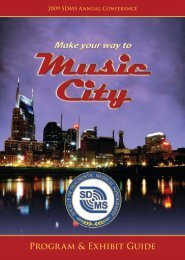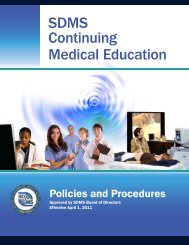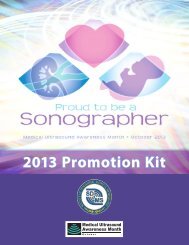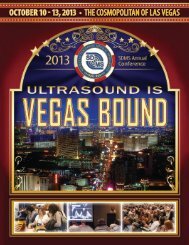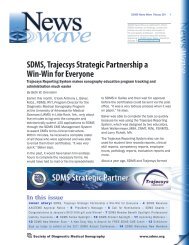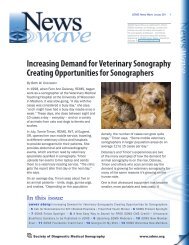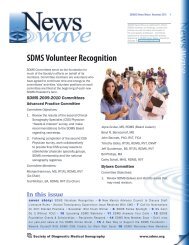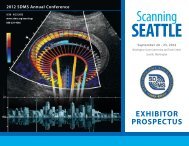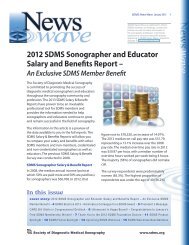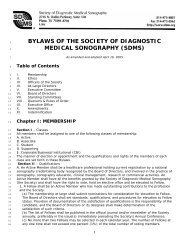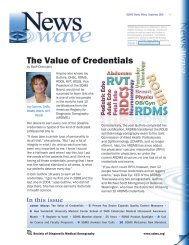Industry Standards - Society of Diagnostic Medical Sonography
Industry Standards - Society of Diagnostic Medical Sonography
Industry Standards - Society of Diagnostic Medical Sonography
Create successful ePaper yourself
Turn your PDF publications into a flip-book with our unique Google optimized e-Paper software.
<strong>Industry</strong> <strong>Standards</strong><br />
for the<br />
Prevention <strong>of</strong> Work-Related<br />
Musculoskeletal Disorders<br />
in <strong>Sonography</strong><br />
Developed through a consensus conference<br />
hosted by<br />
<strong>Society</strong> <strong>of</strong> <strong>Diagnostic</strong><br />
<strong>Medical</strong> <strong>Sonography</strong><br />
May 2003<br />
©Copyright 2003. All rights reserved by the <strong>Society</strong> <strong>of</strong> <strong>Diagnostic</strong> <strong>Medical</strong><br />
<strong>Sonography</strong>, Plano, Texas. Organizations and individuals may use this<br />
document for their own internal use, including copying or distributing the<br />
text, provided that the text is reproduced in its entirety with no changes.<br />
All other uses require prior written permission by the <strong>Society</strong> <strong>of</strong> <strong>Diagnostic</strong><br />
<strong>Medical</strong> <strong>Sonography</strong>.
Consensus Conference<br />
on<br />
Work-Related Musculoskeletal Disorders<br />
in <strong>Sonography</strong><br />
SUMMARY<br />
The <strong>Society</strong> <strong>of</strong> <strong>Diagnostic</strong> <strong>Medical</strong> <strong>Sonography</strong> (SDMS) hosted a consensus<br />
conference on Work-Related Musculoskeletal Disorders* (WRMSD) in<br />
<strong>Sonography</strong> on May 13-14, 2003 in Dallas, Texas. The conference was<br />
chaired by Joan P. Baker, MSR, RDMS, RDCS, FSDMS, founder <strong>of</strong> the SDMS,<br />
and internationally recognized advocate for prevention <strong>of</strong> WRMSD in<br />
sonography. Joan has been a sonographer for 43 years and serves on the<br />
faculty <strong>of</strong> Bellevue Community College. She is also a consultant for occupational<br />
health with Sound Ergonomics LLC, and lectures worldwide.<br />
The goal <strong>of</strong> the conference was to develop risk-reducing industry standards<br />
that serve to address the multifaceted problem <strong>of</strong> WRMSD in sonography.<br />
These industry standards address the role <strong>of</strong> employees, employers, educators,<br />
medical facilities, and equipment manufacturers in reducing the incidence<br />
and impact <strong>of</strong> these injuries on the workforce. These industry standards are<br />
intended to assist all stakeholders in making informed decisions. Adoption<br />
<strong>of</strong> these industry standards will improve the well-being <strong>of</strong> sonographers and<br />
sonologists and hopefully assist in addressing the workforce shortage in the<br />
pr<strong>of</strong>ession.<br />
This document reflects the consensus achieved by the conference participants.<br />
* Musculoskeletal Disorders: a range <strong>of</strong> conditions caused by repetitive,<br />
forceful or awkward movements that cause injury to muscles, tendons, and<br />
ligaments.<br />
PARTICIPANTS<br />
Representatives <strong>of</strong> the following organizations/corporations participated in<br />
the Consensus Conference:<br />
American Healthcare Radiology Administrators<br />
American Institute <strong>of</strong> Ultrasound in Medicine<br />
American <strong>Society</strong> <strong>of</strong> Echocardiography<br />
Amersham Health<br />
American Registry <strong>of</strong> <strong>Diagnostic</strong> <strong>Medical</strong> Sonographers
Australian Sonographers Association<br />
Biodex <strong>Medical</strong> Systems<br />
Biosound Esaote<br />
Bristol-Myers Squibb, <strong>Medical</strong> Imaging<br />
Canadian <strong>Society</strong> <strong>of</strong> <strong>Diagnostic</strong> <strong>Medical</strong> Sonographers<br />
Joint Review Committee on Education in Cardiovascular Technology<br />
Joint Review Committee on Education in <strong>Diagnostic</strong> <strong>Medical</strong> <strong>Sonography</strong><br />
GE <strong>Medical</strong> Systems-Ultrasound<br />
Heritage <strong>Medical</strong> Products<br />
Hitachi <strong>Medical</strong> Systems America<br />
<strong>Medical</strong> Positioning<br />
MediVision<br />
Philips <strong>Medical</strong> Systems-Ultrasound<br />
Precision Interconnect<br />
Siemens <strong>Medical</strong> Solutions<br />
<strong>Society</strong> <strong>of</strong> <strong>Diagnostic</strong> <strong>Medical</strong> <strong>Sonography</strong><br />
<strong>Society</strong> <strong>of</strong> Radiographers (United Kingdom)<br />
<strong>Society</strong> for Vascular Ultrasound<br />
SonoSite<br />
Sound Ergonomics<br />
Sound Technology<br />
W.L. Gore and Associates<br />
CONSENSUS CONFERENCE PROCESS<br />
Participants at the Consensus Conference were invited stakeholder groups,<br />
pr<strong>of</strong>essional organizations, and credentialing, accreditation, and governmental<br />
agencies. It was recognized that participants presented their personal views<br />
on the issues and not necessarily those <strong>of</strong> the organizations, agencies, or<br />
companies they represented. These standards are not a policy statement <strong>of</strong><br />
any <strong>of</strong> the participating organizations, companies, or agencies.<br />
Consensus Conference participants reviewed an extensive collection <strong>of</strong> literature<br />
related to WRMSD in sonography. They also heard presentations by international<br />
experts in the field including:<br />
Grahame Brown, BSc, MRCGP, DipSportsMed, AFOM, FHGI, FFSEM<br />
Consultant in Musculoskeletal, Sports, and Exercise Medicine<br />
Specialist in Occupational and Psychological Medicine<br />
The Royal Orthopaedic Hospital<br />
Birmingham, United Kingdom<br />
Val Gregory, MIR, AMS, M Mgt<br />
Royal Prince Alfred Hospital<br />
Sydney, Australia
Daniel J. Habes, MSE, CPE<br />
Industrial Engineer<br />
Industrial Hygiene Section<br />
Hazard Evaluations and Technical Assistance Branch<br />
Division <strong>of</strong> Surveillance, Hazard Evaluations, and Field Studies<br />
National Institute for Occupational Safety and Health (NIOSH)<br />
Cincinnati, Ohio<br />
Susan Murphey, BS, RDMS, RDCS<br />
Consultant for Sonographer Health<br />
Sound Ergonomics, LLC<br />
Kenmore, Washington<br />
For this conference, consensus was broadly defined as agreement that the<br />
recommendations under discussion were acceptable to participants. Consensus<br />
was further clarified as being more than a simple majority. Although<br />
unanimity was not required, it was achieved. In the final consensus-achieving<br />
session <strong>of</strong> the conference, the chair declared consensus when participants<br />
demonstrated that they supported the recommendations under discussion and<br />
no participant expressed unyielding disagreement with the recommendations.<br />
The recommendations reflect current knowledge presented at the conference<br />
and held by participants, corroborated by a systematic review <strong>of</strong> the literature<br />
(1985 to 2002). The recommendations are subject to change in the light <strong>of</strong><br />
future developments. They provide detailed industry standards advocating<br />
best practices and control measures to prevent WRMSDs.<br />
BACKGROUND<br />
More than 80% <strong>of</strong> sonographers are scanning in pain and 20% <strong>of</strong> these<br />
pr<strong>of</strong>essionals eventually experience a career-ending injury. On average,<br />
within 5 years <strong>of</strong> entering the pr<strong>of</strong>ession, sonographers experience pain while<br />
scanning. 1<br />
The increasing loss <strong>of</strong> sonographers due to WRMSDs exacerbates the existing<br />
shortage <strong>of</strong> sonographers in the workplace and decreases patient access to<br />
this important healthcare service.<br />
The economics <strong>of</strong> ergonomics is also an important consideration. A workstation<br />
including the cost <strong>of</strong> an ergonomically designed state-<strong>of</strong>-the-art ultrasound<br />
system, a table, chair, and accessories can be purchased for $188,200. In<br />
contrast, failure to address ergonomics in the workplace setting can result in<br />
$580,000 in revenue loss, medical bills, average cost <strong>of</strong> a Worker’s Compensation<br />
claim, and new staff recruitment. Temporary staffing from an agency can<br />
cost an additional $80,000. 2
REFERENCES<br />
1. <strong>Society</strong> <strong>of</strong> <strong>Diagnostic</strong> <strong>Medical</strong> <strong>Sonography</strong>. <strong>Sonography</strong> Benchmark Survey.<br />
Dallas, Texas; 2000.<br />
2. Sound Ergonomics. Manpower Shortages are Costly. Available at:<br />
http://www.soundergonomics.com/Pages/Admin_Risk/ergoeconomics.htm<br />
Accessibility verified May 29, 2003.
<strong>Industry</strong> <strong>Standards</strong><br />
for the<br />
Prevention <strong>of</strong> Work-Related Musculoskeletal<br />
Disorders in <strong>Sonography</strong><br />
Work-related musculoskeletal disorders (WRMSDs) affect a large<br />
number <strong>of</strong> sonographers and sonologists, particularly those with<br />
heavy workloads and those who have been in the pr<strong>of</strong>ession for a<br />
long time. Good ergonomic design must be an integral part <strong>of</strong><br />
equipment design, and significantly influence purchasing decisions.<br />
The employer, manufacturer, user, and educational programs have<br />
the responsibility to prevent health and safety problems that cause<br />
WRMSDs.<br />
I. EQUIPMENT CONTROL MEASURES<br />
A. ULTRASOUND SYSTEM<br />
State-<strong>of</strong>-the-art equipment allows for optimal visualization which<br />
increases diagnostic accuracy and reduces sonographer/sonologist<br />
fatigue. These industry standards are specific to floor-standing models.<br />
Therefore, some recommendations may not apply to non-floor-standing<br />
models.<br />
1. Fully adjustable equipment that suits the anthropometrics <strong>of</strong><br />
the 5 th to 95 th percentile <strong>of</strong> the population and is specific to the<br />
demographic area <strong>of</strong> the users. 1<br />
2. Easily accessible controls for achieving two-wheel, four-wheel, and<br />
braked positions. Central locking is preferable.<br />
3. Recording devices positioned to minimize the user’s reach to<br />
external devices; external devices should not interfere with<br />
adjustability <strong>of</strong> the system.<br />
4. Footrest on the equipment designed to encourage neutral position<br />
<strong>of</strong> the ankle.<br />
5. Transducer holder incorporates ease <strong>of</strong> access (unobstructed);<br />
should not be detrimental to the distance required to access controls;<br />
low force, minimal effort required for single-handed use.<br />
6. Cables should not interfere with access to equipment or system<br />
interaction.<br />
7. Port Connector permits ease <strong>of</strong> use, single-handed use, minimizing<br />
the user’s reach, force, and necessity <strong>of</strong> a pinch grip; does not<br />
interfere with access to equipment or system interaction.<br />
1
8. System design such that transporting the equipment does not<br />
exceed 50 pounds <strong>of</strong> force for pushing or pulling by a single user<br />
on usual flooring surfaces. Otherwise, it is required that additional<br />
personnel are available to assist in moving the equipment. 2<br />
9. Height-adjustable handles suitable for transporting the equipment.<br />
B. CONTROL PANEL<br />
1. Height-adjustable, separate from the monitor with appropriate<br />
degree <strong>of</strong> tilt to allow for standing or seated user to achieve neutral<br />
posture <strong>of</strong> wrist and forearm. Independent movement <strong>of</strong> control<br />
panel allows users to work while maintaining their elbow at their<br />
side.<br />
2. Optimized control layout to allow use by both right and left-handed<br />
users.<br />
3. Size, shape, and spacing <strong>of</strong> controls designed according to<br />
occupational ergonomic guidelines. 1 Font size and control layout<br />
are visually discernable, according to occupational ergonomic<br />
guidelines. 1 The range <strong>of</strong> illumination permits clear identification<br />
<strong>of</strong> control functions at applicable user positions.<br />
4. Entire system designed to be used in seated position without<br />
obstruction <strong>of</strong> legs/knees.<br />
C. MONITORS<br />
1. Incorporate features to minimize eye strain, such as:<br />
a. Reduced flicker<br />
b. Appropriate brightness and contrast levels<br />
c. Resolution<br />
d. Visual contrast<br />
2. Height-adjustable, separate from the control panel with appropriate<br />
degree <strong>of</strong> tilt to enable standing or seated users to achieve neutral<br />
posture <strong>of</strong> their necks.<br />
3. Single-handed movement <strong>of</strong> the monitor allows users to work<br />
while maintaining their neck in a forward, neutral position at a<br />
range <strong>of</strong> 18 - 30 inches.<br />
4. System must support the ability to use an external monitor. See<br />
page 4: G. Accessories.<br />
D. TRANSDUCERS<br />
1. Lightweight and balanced to minimize torque on the wrist, facilitate<br />
a palmar grip without an expanded stretch <strong>of</strong> the hand, and<br />
encourage a neutral wrist position.<br />
2
2. Sized to support appropriate anthropometric data for the majority<br />
<strong>of</strong> users, encourage a palmar grip, and slip resistant.<br />
3. Cables and cable management systems must be suitable in length<br />
to permit unrestricted use; and be <strong>of</strong> suitable length for intended<br />
applications.<br />
E. TABLE<br />
<strong>Industry</strong> standards #1-5 are considered essential when new or<br />
replacement tables are being purchased.<br />
1. Height-adjustable, capable <strong>of</strong> being adjusted low enough to allow<br />
patients to get on and <strong>of</strong>f easily unassisted, and to allow user to<br />
scan in a sitting or standing position while maintaining arm<br />
abduction <strong>of</strong> less than 30 degrees. 3<br />
2. Maneuverable, full wheel mobility, and wheel locks that are easily<br />
operated.<br />
3. Open access from all sides to allow the users to place their knees<br />
and feet underneath, if needed. Table support structure and/or<br />
table mechanisms should not extend beyond the table top such that<br />
it prevents the user from minimizing reach and arm abduction.<br />
4. For endovaginal scanning, suitable patient access and support<br />
such as adjustable footboard and stirrups.<br />
5. For cardiac imaging, an easily operated, drop away or cut out<br />
section to allow unhindered access to the apical region while<br />
allowing the user’s wrist to remain supported and in a neutral<br />
position.<br />
6. Ideally, electronic controls that are accessible and easy to use.<br />
7. The following options may assist in reducing scan time by<br />
improved patient positioning depending on the procedure:<br />
a. Trendelenberg and reverse Trendelenberg<br />
b. Fowler back (upright table back)<br />
c. Arm extension<br />
d. Central locks<br />
e. Patient restraints<br />
F. CHAIR<br />
1. Height-adjustable with sufficient range to suit the majority <strong>of</strong> the<br />
users. Range <strong>of</strong> height adjustability optimizes positioning <strong>of</strong> less<br />
than 30 degrees abduction <strong>of</strong> the scanning arm and allows the<br />
forearm <strong>of</strong> the non-scanning arm to be approximately parallel to<br />
the floor.³<br />
2. Adjustable lumbar support, adjustable seat for thigh support, and<br />
an adjustable footrest. Seat design must encourage an upright<br />
posture.<br />
3
3. Swivels to allow the user to rotate from the patient to the<br />
ultrasound system while maintaining an aligned posture.<br />
4. Casters suitable to the type <strong>of</strong> flooring.<br />
G. ACCESSORIES<br />
1. Gel bottles should have large openings to reduce the strength<br />
needed to squeeze the bottle and <strong>of</strong> suitable diameter to avoid<br />
extended grip position.<br />
2. Support devices available to all users for arm support in abduction.<br />
3. When required, the patient chair (and/or table converted to sitting<br />
position) used for seated procedures (eg, shoulder ultrasound)<br />
should be fully adjustable, easy to rotate, lockable and armless, or<br />
with removable arms to achieve unobstructed access for proper<br />
ergonomics.<br />
4. A transducer cable support device to allow users to reduce their<br />
grip by reducing the amount <strong>of</strong> torque on the wrist/forearm.<br />
5. Properly fitting, textured exam gloves to reduce the force required<br />
to grip the transducer.<br />
II. ADMINISTRATIVE CONTROL MEASURES<br />
A. EMPLOYER<br />
1. Provide annual education to all users on the risk and prevention <strong>of</strong><br />
musculoskeletal disorders.<br />
2. Perform risk assessments in consultation with the users on a regular<br />
basis to identify musculoskeletal disorders and formulate and<br />
implement controls for the prevention and/or reduction <strong>of</strong> these<br />
disorders.<br />
3. Provide a system to report and document acute or chronic<br />
musculoskeletal disorders per applicable regulations.<br />
4. Conduct risk assessments prior to the purchase <strong>of</strong> equipment.<br />
5. Maintain all equipment in good working order.<br />
B. WORKLOAD AND SCHEDULING<br />
1. Solicit user input on establishing protocols on examination<br />
scheduling.<br />
2. Provide adequate rest breaks between examinations particularly<br />
for procedures comprised <strong>of</strong> similar postural and muscular force<br />
attributes.<br />
3. Encourage task rotation in the workplace as much as possible.<br />
4
4. Establish maximum transducer time per hour. (Research to determine<br />
maximum safe transducer time is encouraged.)<br />
5. Minimize portable/bedside examinations.<br />
C. EXAMINATION AREA<br />
1. Dedicated examination area provides adequate space for the<br />
maneuverability <strong>of</strong> equipment around the exam table and allows<br />
easy access from all sides.<br />
2. Examination room doorway allows easy access for all wheelchairs,<br />
beds, and ultrasound equipment.<br />
3. Suitable flooring to allow easy movement <strong>of</strong> equipment.<br />
4. Adequate ventilation and temperature control to ensure the<br />
comfort <strong>of</strong> user and patient while enabling the equipment to<br />
operate at a functional temperature.<br />
5. Adjustable room lighting with easily accessible dimmer controls;<br />
shaded windows to eliminate light.<br />
6. Accessories that improve posture and reduce muscular force<br />
should be available and easily accessible to the user.<br />
7. All imaging supplies stored in the examination area and easily<br />
accessible.<br />
III. PROFESSIONAL CONTROL MEASURES<br />
A. BEST PRACTICES<br />
It is recommended that sonographers, sonologists, and students follow<br />
current best practices to reduce the risk <strong>of</strong> developing musculoskeletal<br />
disorders. These best practices include:<br />
1. Minimize sustained bending, twisting, reaching, lifting, pressure,<br />
and awkward postures; alternate sitting and standing and vary<br />
scanning techniques and transducer grips.<br />
2. Adjust all equipment to suit user’s size and have accessories on<br />
hand before beginning to scan.<br />
3. Use measures to reduce arm abduction and forward and backward<br />
reach to include: instructing the patient to move as close to the user<br />
as possible; adjust the table and chair; and use arm supports.<br />
4. Relax muscles periodically throughout the day:<br />
a. Stretch hand, wrist, shoulder muscles, and spine<br />
b. Take mini breaks during the procedure<br />
c. Take meal breaks separate from work-related tasks<br />
d. Re-focus eyes onto distant objects<br />
e. Vary procedures, tasks, and skills as much as reasonably possible<br />
5
5. Use correct body mechanics when moving patients, wheelchairs,<br />
beds, stretchers, and ultrasound equipment.<br />
a. Correct body mechanic guidelines are available from employers<br />
or regulatory bodies.<br />
6. Report and document any persistent pain to employer and seek<br />
competent medical advice.<br />
7. Maintain a good level <strong>of</strong> physical fitness in order to perform the<br />
demanding work tasks required.<br />
8. Collaborate with employers on staffing solutions that allow<br />
sufficient time away from work.<br />
B. EDUCATION AND TRAINING<br />
1. Participate in education and training to reduce the risk <strong>of</strong><br />
developing musculoskeletal disorders:<br />
a. Attend employer sponsored in-services<br />
b. Attend seminars, lectures, workshops, or conferences <strong>of</strong>fered by<br />
pr<strong>of</strong>essional organizations or manufacturers<br />
c. Access journals, textbooks, online resources, etc.<br />
d. Attend a formal sonography program that includes WRMSD<br />
prevention in the curriculum<br />
REFERENCES<br />
1. Kroemer K, Grandjean E. Fitting the Task to the Human. A Textbook <strong>of</strong><br />
Occupational Ergonomics. 5 th ed. Philadelphia: Taylor & Francis, Inc; 1997.<br />
2. Eastman Kodak Co, Rodgers SH (ed). Ergonomic design for people at work.<br />
Volume 2. New York: Van Nostrand Reinhold; 1986.<br />
3. Salvendy G. Handbook <strong>of</strong> Human Factors and Ergonomics. New York:<br />
John Wiley & Sons, Inc; 1997.<br />
6
GLOSSARY<br />
Anthropometrics: measured data <strong>of</strong> body dimensions for various<br />
populations.<br />
Demographic area: the characteristics <strong>of</strong> human populations and population<br />
segments, especially when used to identify consumer markets.<br />
Equipment: the ultrasound system without accessories.<br />
Mini breaks: breaks lasting a minute or two taken throughout the examination<br />
study to relax muscles that are put into spasm while scanning. These<br />
muscles include, but are not limited, to the neck, shoulder, wrist, and fingers.<br />
Pressure: force applied uniformly over a surface, measured as force per unit<br />
<strong>of</strong> area. The application <strong>of</strong> continuous force by one body on another that it is<br />
touching; compression.<br />
Sonographer: a pr<strong>of</strong>essional who uses an ultrasound system to create images<br />
<strong>of</strong> structures inside the human body that are used by physicians to make a<br />
medical diagnosis.<br />
Sonologist: a physician who makes a medical diagnosis using ultrasound<br />
and who may also perform ultrasound procedures.<br />
Suitable Flooring: tile, linoleum or other hard surface (not carpeting).<br />
System: all the components <strong>of</strong> an ultrasound unit with accessories such as a<br />
printing device or VCR, or the entire workstation.<br />
Unit: a component <strong>of</strong> an ultrasound system.<br />
User: a pr<strong>of</strong>essional who uses ultrasound to make diagnostic images in a<br />
medical setting.<br />
7


